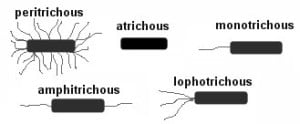Aim:
To determining the motility of living bacteria.
Introduction :
A bacteria, which has the intrinsic ability of movement in the surrounding medium, in which it remains suspended, is a motile bacteria.
Non-motile Bacteria:
A bacteria, which does not have the intrinsic ability of movement in the surrounding medium, in which it remains suspended, is a non-motile bacteria. Non-motile bacteria may show apparent motility, resulting from their brownian movement caused by the bombardment of the water molecules in the surrounding medium, on the bacteria cells.
Most motile bacteria move by use of flagella, thread like locomotor appendages extending outward from the plasma membrane and cell wall. Motile cells may have one flagellum, but most have several. Each flagellum has a very rigid, helical structure and actual motility results from the rotation of the flagellum in a manner similar to that of a boat propeller. Motility by means of flagella is particularly important for the identification of microorganisms, for instance Bacilli are motile except for the anthrax, which is instead capsular, therefore flagella could be produced to enable the organisms to run away from danger and to move from less favorable to more favorable environment.
Types and Examples of Flagella
There are 4 types of flagellar distribution on bacteria-
1. Monotrichous
– Single polar flagellum
– Example: Vibrio cholerae
2. Amphitrichous
– Single flagellum on both sides
– Example: Alkaligens faecalis
3. Lophotrichous
– Tufts of flagella at one or both sides
– Example: Spirillum
4. Peritrichous
– Numerous falgella all over the bacterial body
– Example: Salmonella Typhi
Expected Results:
1. Hanging Drop Method
Hanging drop test is a confirmatory test to identify if an organism is motile or non motile. It can also be used for the presumptive identification of organism on the basis of its characteristic motility.
Materials required:
- Cavity slide
- Cover slip
- Toothpick
- Vaseline/Petroleum Jelly
- Bunsen burner
- Inoculating loop
- Young broth cultures (Proteus sp. and Pseudomonas sp.)
- Microscope
- With a toothpick, spread Vaseline or Petroleum jelly on the four corner of a clean coverslip.
- After thoroughly mixing one of the cultures, use the inoculating loop to aseptically place a small drop of the bacterial suspension in the center of a coverslip
- Lower the cavity slide, with the concavity facing down, onto the coverslip so that the drop protrudes into the center of the concavity of the slide .Press gently to form a seal.
- Turn the hanging drop slide over and place on the stage of the microscope so that the drop is over the light hole. Examine the drop by first locating its edge under low power and focusing on the drop. Switch to the high-dry objective (40 x). To increase the contrast and to see the bacteria clearly, close the diaphragm as much as possible.
Expected Results:
Actively motile organisms were observed
2. Soft Agar Stabbing (Tube Method)
Materials Required :
- Two test tubes with SIM medium
- Inoculating needle
- Cultures:- Nutrient broth cultures (young cultures)
Procedure:
- Label the tubes of semisolid (or SIM) media with the names of the organisms.
- Flame and cool the inoculating needle, and insert it into the culture after flaming the neck of the tube.
- Remove the cap from the tube of medium, flame the neck, and stab it 2⁄3 of the way down to the bottom. Flame the neck of the tube again before returning the cap to the tube.
- Incubate the tubes at room temperature for 24 to 48 hours.
- Examine the SIM cultures for the presence or absence of a black precipitate along the line of the stab inoculation. A black precipitate of FeS indicates the presence of H2S.
- If desired, one can also test for indole production by adding 5 drops of Kovacs’ reagent to the SIM cultures and looking for the development of a red color at the top of the deeps.
Expected Results:
In agar stab method Proteus vulgaris showed a well dispersed growth from the line of inoculation which is evident of motility, presence of black precipitate indicates that H2S is produced and presence of red colouration in the medium after the addition of Kovac’s reagent indicates positive indole test while Klebsiella pneumoniae is non motile and negative for H2S production and indole test .
Ref: http://vlab.amrita.edu/?sub=3&brch=73&sim=697&cnt=2





No comments:
Post a Comment